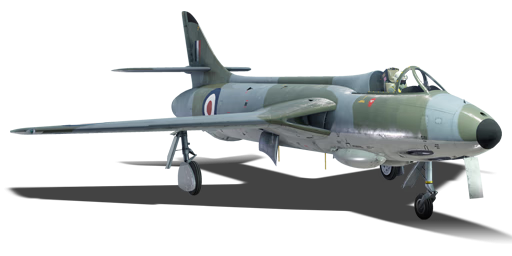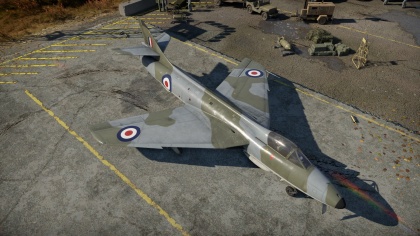Difference between revisions of "Hunter F.6"
(→Pros and cons) (Tag: Visual edit) |
Soggeymilk (talk | contribs) (→General info) (Tag: Visual edit) |
||
| Line 151: | Line 151: | ||
The Hunter F.6 Is a Transonic aircraft in level flight but can reach supersonic in a dive. That means that it is faster than other subsonic aircraft it will face but slower than supersonic aircraft like the F-100D and the MiG-19PT. Make sure to maintain speed, as it is most maneuverable at higher speeds, and very slow to turn at low. The energy retention is almost an order of magnitude higher than supersonic aircraft, which bleed speed in sharp turns, so the best way to fight them is to engage in a dogfight with them, or make them turn to reduce their speed to the point they become vulnerable. When facing subsonic aircraft, simply outrun them with your superior speed, try not to engage in a turn-fight with subsonic aircraft, as they are often able to best you in a dogfight, especially at low speeds, where the Hunter really shows its weaknesses. | The Hunter F.6 Is a Transonic aircraft in level flight but can reach supersonic in a dive. That means that it is faster than other subsonic aircraft it will face but slower than supersonic aircraft like the F-100D and the MiG-19PT. Make sure to maintain speed, as it is most maneuverable at higher speeds, and very slow to turn at low. The energy retention is almost an order of magnitude higher than supersonic aircraft, which bleed speed in sharp turns, so the best way to fight them is to engage in a dogfight with them, or make them turn to reduce their speed to the point they become vulnerable. When facing subsonic aircraft, simply outrun them with your superior speed, try not to engage in a turn-fight with subsonic aircraft, as they are often able to best you in a dogfight, especially at low speeds, where the Hunter really shows its weaknesses. | ||
| − | The | + | The SRAAM (Short Range Air to Air Missiles) have a unique playstyle. They are much shorter range than other missiles, but extremely maneuverable, able to turn inside most aircraft. Never fire them at targets more than one kilometre out, as the missile will run out of fuel before reaching its target. The best use case is to fire them while in a turn with another aircraft, as the missile is maneuverable enough to cut them off. |
=== Manual Engine Control === | === Manual Engine Control === | ||
Revision as of 18:50, 17 October 2019
Contents
| This page is about the British jet fighter Hunter F.6. For the other version, see Hunter F 1. |
Description
The Hunter F.6 is a rank VI British jet fighter
with a battle rating of 10.0 (AB) and 9.7 (RB/SB). It was introduced in Update 1.89 "Imperial Navy".
General info
Flight performance
Describe how the aircraft behaves in the air. Speed, manoeuvrability, acceleration and allowable loads - these are the most important characteristics of the vehicle.
| Characteristics | |||||||
|---|---|---|---|---|---|---|---|
| Stock | |||||||
| Max Speed (km/h at 0 m - at sea level) |
Max altitude (meters) |
Turn time (seconds) |
Rate of climb (meters/second) |
Take-off run (meters) | |||
| AB | RB | AB | RB | AB | RB | ||
| 1138 | 1132 | 15500 | 25.8 | 27.2 | 56.1 | 50 | 820 |
| Upgraded | |||||||
| Max Speed (km/h at 0 m - at sea level) |
Max altitude (meters) |
Turn time (seconds) |
Rate of climb (meters/second) |
Take-off run (meters) | |||
| AB | RB | AB | RB | AB | RB | ||
| 1159 | 1,148 | 15500 | 24.5 | 25.0 | 86 | 70 | 820 |
Details
| Features | ||||
|---|---|---|---|---|
| Combat flaps | Take-off flaps | Landing flaps | Air brakes | Arrestor gear |
| ✓ | ✓ | ✓ | ✓ | X |
| Limits | ||||
|---|---|---|---|---|
| Wing-break speed (km/h) |
Gear limit (km/h) |
Combat flaps (km/h) |
Max Static G | |
| + | - | |||
| 620 | ~12 | ~5 | ||
| Optimal velocities | |||
|---|---|---|---|
| Ailerons (km/h) |
Rudder (km/h) |
Elevators (km/h) |
Radiator (km/h) |
| < 850 | < 600 | < 690 | N/A |
| Compressor (RB/SB) | ||
|---|---|---|
| Setting 1 | ||
| Optimal altitude | 100% Engine power | WEP Engine power |
| 0 m | 4,200 kgf | N/A |
Survivability and armour
- 64 mm Bulletproof glass - Armored windscreen
- 12.7 mm Steel - Armor plate behind the pilot
Armaments
Offensive armament
The Hunter F.6 is armed with:
- 4 x 30 mm ADEN cannons, chin-mounted (150 rpg = 600 total)
Suspended armament
The Hunter F.6 can be outfitted with the following ordnance:
- Without load
- 2 x 500 lb H.E. M.C. Mk.II bombs (1,000 total)
- 4 x 500 lb H.E. M.C. Mk.II bombs (2,000 total)
- 2 x 1,000 lb M.C. 1,000 lb Mk.I bombs (2,000 lb total)
- 4 x 1,000 lb M.C. 1,000 lb Mk.I bombs (4,000 lb total)
- 2 x 1,000 lb M.C. 1,000 lb Mk.I bombs + 2 x 500 lb H.E. M.C. Mk.II bombs (3,000 lb total)
- 4 x SRAAM missiles
- 2 x 500 lb H.E. M.C. Mk.II bombs + 36 x SNEB Type 23 rockets (1,000 lb total)
- 2 x 1,000 lb M.C. 1,000 lb Mk.I bombs + 36 x SNEB Type 23 rockets (2,000 lb total)
- 36 x SNEB Type 23 rockets
- 36 x SNEB Type 23 rockets + 4 x SRAAM missiles
Usage in battles
The Hunter F.6 Is a Transonic aircraft in level flight but can reach supersonic in a dive. That means that it is faster than other subsonic aircraft it will face but slower than supersonic aircraft like the F-100D and the MiG-19PT. Make sure to maintain speed, as it is most maneuverable at higher speeds, and very slow to turn at low. The energy retention is almost an order of magnitude higher than supersonic aircraft, which bleed speed in sharp turns, so the best way to fight them is to engage in a dogfight with them, or make them turn to reduce their speed to the point they become vulnerable. When facing subsonic aircraft, simply outrun them with your superior speed, try not to engage in a turn-fight with subsonic aircraft, as they are often able to best you in a dogfight, especially at low speeds, where the Hunter really shows its weaknesses.
The SRAAM (Short Range Air to Air Missiles) have a unique playstyle. They are much shorter range than other missiles, but extremely maneuverable, able to turn inside most aircraft. Never fire them at targets more than one kilometre out, as the missile will run out of fuel before reaching its target. The best use case is to fire them while in a turn with another aircraft, as the missile is maneuverable enough to cut them off.
Manual Engine Control
| MEC elements | ||||||
|---|---|---|---|---|---|---|
| Mixer | Pitch | Radiator | Supercharger | Turbocharger | ||
| Oil | Water | Type | ||||
| Not controllable | Not controllable Not auto controlled |
Not controllable Auto control available |
Not controllable Auto control available |
Combined | Not controllable 1 gear |
Not controllable |
Modules
| Tier | Flight performance | Survivability | Weaponry | ||
|---|---|---|---|---|---|
| I | Fuselage repair | Offensive 30 mm | 2 500 LB GP | ||
| II | New boosters | Compressor | Airframe | 1000 LB GP | |
| III | Wings repair | Engine | New 30 mm cannons | Matra SNEB | |
| IV | G-suit | Cover | SRAAM | ||
Pros and cons
Pros:
- Highly agile short-range air-to-air missiles
- Deadly 30mm ADEN cannons
- Enhanced handling at high speeds
- Bomb and rocket hardpoints
- Good payload options
Cons:
- Subsonic
- No afterburner
- As with most jets, not very maneuverable at low speeds
History
With the availability of the more powerful Rolls-Royce Avon 200 series engines in the early 1950s, the Hawker company began developing a new modification of their Hunter jet fighter, which would eventually result in the creation of the Hunter F.6 - one of the last dedicated fighter modifications of this aircraft.
The new Hunter featured, apart from a more powerful engine, a number of other tweaks and changes, most notably, a redesigned wing which contributed to the aircraft’s overall stability during transonic flight. The first prototype of the F.6 flew in January 1954, with serial production commencing in 1956. Overall, 383 aircraft of the type entered service with the RAF before being decommissioned in the early 1980s.
In the late 1970s, the Hunter F.6 was used as a testbed for a new type of air-to-air missile developed by Hawker Siddeley since the late ‘60s. The SRAAM, or Short Range Air-to-Air Missile, was a weapon system developed as an alternative to the American Sidewinder and the British Firestreak missiles.
As the name suggests, the SRAAM was designed for shorter range deployments during dogfights, in situations where pilots would find it difficult to achieve a reliable lock-on with existing missiles. As such, the SRAAM possessed extremely good agility and didn’t cost as much to produce, but was severely limited in range. Despite this however, the weapon didn’t see active use, but was instead further developed into a more advanced version which eventually did get adopted and is still in use today.
- From Devblog
Media
See also
Links to the articles on the War Thunder Wiki that you think will be useful for the reader, for example:
- Hunter F 1
- links to approximate analogues of other nations and research trees.
External links
| Britain jet aircraft | |
|---|---|
| Blackburn | Buccaneer S.1 · Buccaneer S.2 · Buccaneer S.2B |
| British Aerospace | Harrier GR.7 · Sea Harrier FRS.1 (e) · Sea Harrier FRS.1 · Sea Harrier FA 2 |
| British Aircraft Corporation | Strikemaster Mk.88 |
| English Electric | Canberra B Mk 2 · Canberra B (I) Mk 6 · Lightning F.6 · Lightning F.53 |
| Gloster | Meteor F Mk 3 · Sea Meteor F Mk 3 · Meteor F Mk 4 G.41F · Meteor F Mk 4 G.41G · Meteor F Mk 8 G.41K · Meteor F Mk.8 Reaper |
| Javelin F.(A.W.) Mk.9 | |
| de Havilland | Vampire F.B.5 · Venom FB.4 · Sea Venom FAW 20 · Sea Vixen F.A.W. Mk.2 |
| Hawker | Sea Hawk FGA.6 · Hunter F.1 · Hunter F.6 · Hunter FGA.9 · Harrier GR.1 · Harrier GR.3 |
| Panavia | Tornado GR.1 · Tornado GR.4 · Tornado F.3 · Tornado F.3 Late |
| SEPECAT | Jaguar GR.1 · Jaguar GR.1A · Jaguar IS |
| Supermarine | Attacker FB 1 · Attacker FB.2 · Scimitar F Mk.1 · Swift F.1 · Swift F.7 |
| Foreign | Phantom FG.1 (USA) · Phantom FGR.2 (USA) · F-4J(UK) Phantom II (USA) |
| Australia | F-111C |
| India | ▄MiG-21 Bison |
| South Africa | ▄JAS39C |





